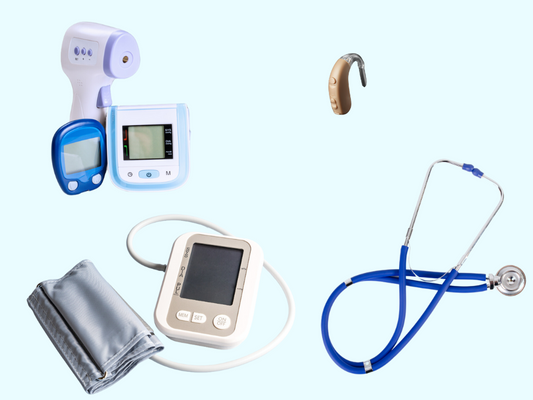Medical thermometers have undoubtedly become part of every household's inventory, including the homes, health centers, and hospitals. A bright side to it, being a regular check-up or measuring the temperature of a sick person, is to consider properly the choice between two types of thermometers to make a big difference. This article discusses the differences between electronic and mechanical thermometers and indicates what is the best option for you.
Introduction
Medical thermometers come in various forms, but the two most common types are digital and manual. Both come with a set of pros and cons. Recognizing this can help you to select an informed decision and achieve correct and reliable health management by getting a good temperature reading accurate error-free result.
Understanding Digital Thermometers
Digital thermometers have become very common these days. People are using these due to their easy operation and rapid results. They use electronic sensors that measure the body's temperature and present the pattern on a digital screen.
Types of Digital Thermometers
-
Oral Digital Thermometers: The ones put under the tongue and the best readings within seconds are given to the patient
-
Infrared Forehead Thermometers: Head thermometers that the patient puts on their forehead
-
Ear (Tympanic) Thermometers: It is also the reason behind the infrared technology that is making measurements of temperature from the ear canal a breeze
-
Rectal Digital Thermometers: Often times used for infants, which is smaller and better than one which uses the ear canal. The digital model gives precise readings even from the smallest child. And so on.
Advantages of Digital Thermometers
-
Accuracy: A large advantage is that digital thermometers provide precise readings that are often accurate to within a fraction of a degree.
-
Speed: They provide quick results, typically within a few seconds.
-
Quick results: They give quick results, generally within just a few seconds.
-
Easy To Carry Out: The digital screen is clear to read and the device that comes with memory recall and fever alert functionalities is nowadays available in the market.
Disadvantages of Digital Thermometers
-
Battery Dependency: Digital models have a power supply of one battery or several batteries of various voltages which are nevertheless capable of running down when they find their power to be exhausted.
-
Cost: They cost a little more than manual thermometers, but still that is okay.
-
Faulty Malfunction: Some electronic components are just aged and therefore could burn out or give inaccurate readings in case you haven't serviced them properly.
Understanding Manual Thermometers
Manual Celsius thermometers are also called mercury or alcohol thermometers. People have been using them for more than 15 years. The way they work is simple. A mercury glass tube or an alcohol thermometer widens and shrinks at every change of temperature.
Types of Manual Thermometers
-
Mercury Thermometers: Through the movement of mercury, a dense liquid metal, it measures temperature.
-
Alcohol Thermometers: It is the use of colored, safer alternative to mercury
Advantages of Manual Thermometers
-
No Batteries Needed: Manual thermometers are hand-held equipment and are thus responsible for not needing batteries, never wait for them; they are thus always available.
-
Durability: You can use a mercury thermometer with the utmost care for longer periods of time than with a digital version.
-
Cost-Effective: The general rule is that manual thermometers are typically less expensive than digital ones.
Disadvantages of Manual Thermometers
-
Readability: Observing what point the directing here is that it can be very difficult to read a handheld thermometer and also require human intervention.
-
Speed: The mercury strain is a nontoxic alternative to batteries and will last for 10 years if used with care. Speed: They take longer to provide a reading, usually a few minutes
-
Safety Concerns: Mercury thermometers can be hazardous if broken, as mercury is a toxic substance.
Comparing Digital and Manual Thermometers
Accuracy and Reliability
Unlike manual thermometers, digital ones are usually trustworthy and without any mistakes. In the process of measuring, manual thermometers usually have various types of errors due to involvement of humans.
Speed and Convenience
Digital ones can be comparatively quicker and easier since they display results in just seconds. As analog thermometers solely rely on the mercury fill, the measurement procedure takes additional time to accomplish the task. The whole procedure also involves a longer wait until the analog thermometer reaches its final reading.
Cost and Accessibility
Whether it is the accuracy, precision or the price, the digital apart from being more expensive, has cutting edge technology. On the other hand, manual thermometers, despite being costly, have some special characteristics which make them useful for some people. Hence, people in developed countries lead in manual thermometers usage, while digital ones are equally used worldwide.
Safety and Hygiene
While some manual thermometers pose a threat to human health through dangerous contents that may result from leakage, analog thermometers are less affectionate and less hygienic. The most hygienic, particularly non-contact thermometers, are the digital ear and forehead thermometer.
Special Considerations
The users at home, prefer the ear thermometers mainly to the ear for being fast, easy to handle, and the safety they offer. The digital forehead thermometer is especially the favorite because it does not involve any contact with the body.
For Clinical Settings
In a healthcare setting, it is common to use both digital and manual thermometers. Digital ones are used for their precision and fastness, whereas analog ones can replace the primary ones if they go wrong.
For Infants and Young Children
Rather than the digital thermometer, the rectal and infrared ones are the best among them when it comes to young children and infants. Also, they do not cause the patient discomfort and give accurate readings quickly.
Future Trends in Thermometers
Due to the new era of technology development, the way digital thermometers are made will also change. The new technologies that are likely to be the feet the smartphone, ensuring a very accurate measurement, and the option to get your data on a mobile phone.
Conclusion
Digital Thermometers and manual Thermometers are two types of Thermometers and they have similarities but there are otherwise different. If you are going to use it digitally or manually, it depends on the reasons you will use them and what you prefer. In a digital one, the benefits of a digital thermometer are convenience generally interpreted and of course high accuracy that has no rival Nevertheless, the manual thermometers are also a crucial method and in many cases, they are the cheapest device for traditional purposes.







